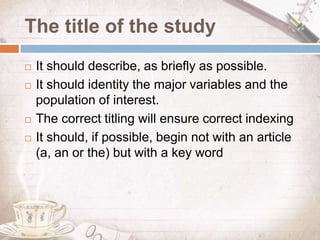research report writing
- 1. TBI 1 A 1. LAFINA SYIFAUL ‘ULA (12510174023) 2. MEILIANA HIDAYATI (12510174027) 3. MOH NOFAL (12510174031)
- 2. Meaning of Research Report: Research report writing is the oral or written presentation of the evidence and the findings in such detail and form as to be readily understood and accessed by the reader and as to enable him to verify the validity of the conclusions.
- 3. Structure of Research Report Generally, a research report, whether it is called dissertation or thesis 1) The Preliminary pages 2) The text of the report / Main body of the report 3) The Reference material.
- 4. PRELIMINARY PAGES Title pages Abstract Acceptance page Acknowledgements or preface Table of contents List of tables List of figures
- 5. The title of the study It should describe, as briefly as possible. It should identity the major variables and the population of interest. The correct titling will ensure correct indexing It should, if possible, begin not with an article (a, an or the) but with a key word
- 6. Abstract It should include a precise statement of the problem, concise descriptions of the research method, result and conclusions. It must be limited in length (500 words or less)
- 7. MAIN BODY OF THE REPORT Introduction Review of literature Methods Result/Finding Discussion Conclusion
- 8. CHAPTER 1-INTRODUCTION 1.0 Introduction 1.1 Background of the study 1.2 Problem Statement 1.3 Purpose and objective of the study 1.4 Research Questions 1.5 Definition of Terms 1.6 Significance of the study
- 9. Introduction It begins with a statements of the research question (problem). Give the background of the problem State why you think your study will make contribution to knowledge in the area State the hypothesis State the reasoning that led to your expectation about the result of the study Define any terms that might be unfamiliar to readers
- 10. CHAPTER 2-LITERATURE REVIEW 2.0 Introduction 2.1 Body of the literature 2.1.1 General area of research 2.1.2 Underlying theory 2.1.3 Variables used from previous literature 2.2 Theoretical Framework 2.3 Hypotheses 2.4 Conclusion
- 11. Review of Literature It contains an extensive review of the literature related to your problem. Do not just list studies one after the other, but rather, synthesize their findings and point out agreements and disagreements among them. Show how they related to your research problem.
- 12. CHAPTER 3 – RESEARCH METHODOLOGY 3.0 Introduction 3.1 Research Design 3.2 Variable and Measurement 3.3 Questionnaire design 3.4 Population and Sample 3.5 Scope of the study 3.6 Data analysis method 3.6.1 Goodness of data 3.6.2 Inferential analysis 3.7 Conclusion
- 13. Methods This chapter presents a detailed description of the methodology. It typically has subsections with information of the participants, the research design, the variables and treatments, materials used to collect data, procedures and the locations of the study.
- 14. CHAPTER 4- RESEARCH FINDINGS 4.1 Introduction 4.2 Goodness of Measure 4.2.1 Representativeness of data 4.2.2 Validity test 4.2.3 Reliability test 4.3 Inferential analysis 4.3.1 Descriptive analysis 4.3.2 Test of difference 4.3.3 Test of relationship Correlation analysis Hypothesis testing 4.4 Conclusion
- 15. Result/Finding It presents the outcomes of the statistical analyses of data. To facilitate comprehension, tables and figures are usually used to presents the findings A table shows a quantitative data A figure shows a data in diagram or graphical form Well construct tables and figures should “stand alone” Use present tense when pointing out the significant aspects of a table or figure.
- 16. Discussion This section assesses how one’s research findings relate to what the community of scholars knew already. Discuss the general significance of your topic and findings. You should discuss the shortcomings of your study and what implications these have for your findings. Discuss things future researchers should investigate about your topic. Leave the reader with the understanding he or she ought to have about the topic you spent so much time exploring.
- 17. Conclusion and Summary • You should summarize the most salient points of your research (tell the reader what you found out about your topic). The summary usually includes a brief restatement of the problem(s), the main features of the methods, and the most important fndings. On completing a draft of this section, check it carefully to determine whether it gives a concise but reasonably complete description of the study and its fndings. Also check to ascertain that no information has been introduced here that was not included in the appropriate preceding sections. It is a good idea to have a colleague read the conclusions section to determine if you are communicating as well as you intended.
- 18. References The references are just as important as any other part of your paper. They are the link to the community of scholars that will permit your reader to assess the worthiness of the claims you make in your paper. References also make the research process much more efficient because they make it very easy to look up sources of facts and ideas.
- 19. Appendixes The appendixes contain pertinent materials that are not important enough to include in the body of the report but may be of value to some readers. Such materials may include complete copies of locally devised tests or questionnaires together with the instructions and scoring keys for such instruments, item analysis data for measurements used, verbatim instructions to subjects, and tables that are very long or of only minor importance to the study
- 20. JOURNAL ARTICLE
- 21. Elements Title Abstract Introduction Methods Finding Discussion Conclusion References Appendices
- 22. In journal article, the elements used are more less same with the desertation report. Hence, these are the differences: • The length is about 100-150 words Abstract • The finding in journal article, however, become the grearest interest to the reader • It also represens a greater proportion of the article than in desertation Finding






















